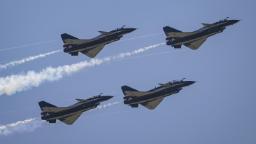
Taipei, Taiwan
CNN
—
China sent 47 aircraft across the median line of the Taiwan Strait on Sunday, its largest incursion into Taiwan’s air defense zone in recent months, as Beijing steps-up efforts to normalize aggressive military operations around the self-ruled island.
The incursions were made by 42 J-10, J-11, J-16 and Su-30 fighter jets, two Y-8 maritime patrol aircrafts, a KJ-500 early warning aircraft, as well as a CH-4 and a WZ-7 military drone, according to the Taiwanese defense ministry.
It added that a total of 71 Chinese aircraft were spotted around the island, and that Taiwan’s military have responded by tasking combat air patrol aircrafts, navy vessels, and land-based missile systems.
The flights, part of a so-called “strike drill” according to China’s military, follow Naval exercises by a Chinese aircraft carrier group in the Western Pacific close to Japan on Friday.
China’s ruling Communist Party views Taiwan – a democratically governed island of 24 million – as part of its territory, despite having never controlled it. It has long vowed to “reunify” the island with the Chinese mainland, by force if necessary.
Tensions surrounding Taiwan have increased markedly this year. A visit to the island by US House Speaker Nancy Pelosi in August prompted fury from the Communist Party and an immediate flurry of military exercises.
Since then, Beijing has stepped up aggressive military pressure tactics on the island, sending fighter jets across the median line of the Taiwan Strait, the body of water separating Taiwan and China and into the island’s air defense identification zone – a buffer of airspace commonly referred to as an ADIZ.
For decades, the median line had served as an informal demarcation line between the two, with military incursions across it being rare.
The newest activities came as the Chinese military’s Eastern Theater Command said Sunday it conducted joint combat readiness patrol and “strike drills” around Taiwan, in response to “provocations” between Taiwan and the United States, without providing specific details.
“The troops will take all necessary measures to resolutely defend national sovereignty and territorial integrity,” the Eastern Theater Command said.
On Friday, US President Joe Biden signed a sweeping new defense bill into law that included the establishment of a defense modernization program for Taiwan to deter Chinese aggression.
The Taiwanese defense ministry responded in a statement Sunday night that it has confidence in defending its sovereignty. “The actions of the Chinese Communist Party highlighted its mentality of using force to resolve differences, which undermines regional peace and stability,” it said.
“The cooperation between Taiwan and the United States will help safeguard a free, open and stable Indo-Pacific region. The military will continue to strengthen military preparedness based on enemy threats and self-defense needs,” it added.
In November, Biden met Chinese leader Xi Jinping in-person for the first time during his presidency at the G20 summit in Indonesia. Afterward, Biden described the three-hour meeting as “open and candid,” and cast doubt on an imminent invasion of Taiwan.
Formal bilateral talks on climate cooperation are expected to resume as well as part of a broader set of agreements between Biden and Xi – with China having previously halted talks as part of retaliation for Pelosi’s visit to Taiwan.
Last Friday, China also conducted a series of military drills close to Japan’s southern Okinawa island in the Pacific Ocean, according to Japanese authorities.
The Chinese navy’s Liaoning aircraft carrier, as well as two destroyers and a frigate, sailed about 560 kilometers (about 348 miles) east of Kitadaito Island, located off Okinawa’s east coast, on December 21, according to Japan’s Joint Staff. The vessels also sailed roughly 120 kilometers (74 miles) east of Okinotorishima, located further southeast, on December 22.
Then on Friday, around 180 carrier-based fighter jets and helicopters took off and landed on the Liaoning aircraft carrier, according to Japan’s defense ministry.
Japan’s Ministry of Defense and Self-Defense Forces responded by dispatching two escort ships to collect information and carry out warning and surveillance, the ministry said.
Tensions between China and Japan have also been rising steadily, with Beijing growing its naval and air forces in areas near Japan. China also claims the Senkaku Islands, an uninhabited Japanese-controlled chain in the East China Sea.
Chinese ships have been making frequent forays near the islands, which it calls the Diaoyus, while Japan scrambles warplanes almost daily in response to Chinese planes nearing its airspace.
Earlier this month, Japan unveiled a new national security plan that signals the country’s biggest military buildup since World War II, doubling defense spending and veering from its pacifist constitution in the face of growing threats China, North Korea and Russia.
Note:- (Not all news on the site expresses the point of view of the site, but we transmit this news automatically and translate it through programmatic technology on the site and not from a human editor. The content is auto-generated from a syndicated feed.))




Thank you for your sharing. I am worried that I lack creative ideas. It is your article that makes me full of hope. Thank you. But, I have a question, can you help me?
Hi there all, here every one is sharing these kinds of
know-how, thus it’snice to read this weblog, and I used
to pay a quick visit this web site everyday.
Check out my blog website
Very good info. Lucky me I ran across your website by accident (stumbleupon).
I’ve book marked it for later!
When I originally commented I seem to have clicked the -Notify me
when new comments are added- checkbox and from now on every time a comment is added I get four emails with the exact same comment.
Is there an easy method you are able to remove me from that service?
Thanks a lot!
I couldn’t resist commenting. Very well written!